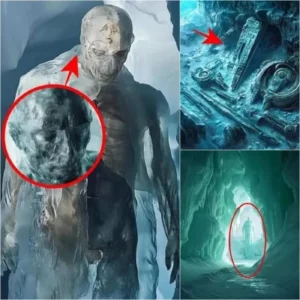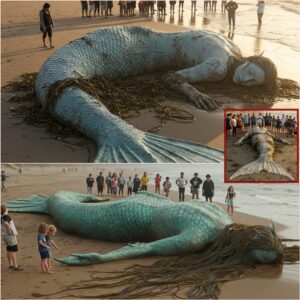In December 2024, an international team of marine researchers made a groundbreaking discovery that shocked the scientific community. During an expedition to the infamous Bermuda Triangle, a region steeped in mystery and legend, they discovered something that could change our understanding of evolutionary history: the fossil of a mermaid-like creature.
At a depth of over 2,000 meters, where sunlight barely penetrates, the team used advanced remotely operated vehicles (ROVs) to map the ocean floor. They stumbled upon a natural, cavern-like structure and, upon further exploration, discovered scattered bone fragments. To their surprise, a nearly intact skeleton was recovered from the site.
What made this find truly extraordinary was the skeleton’s hybrid anatomy. The upper half bore a striking resemblance to human skeletal structures, including arms, shoulders, and ribs, while the lower half featured a large, fish-like tail, complete with flexible joints. The fossilized remains measured approximately 2.5 meters in length.
This discovery has sparked a fierce debate among scientists. Could this be proof that “mermaids” (creatures of myth and folklore) really existed? Or is it a previously unknown species occupying a unique evolutionary niche between humans and aquatic life?
Preliminary theories suggest that this creature could represent a lineage of ancient humans who adapted to life underwater. Others propose that it could be a marine species that evolved a humanoid appearance as a result of convergent evolution. DNA analysis and radiocarbon dating will be crucial to unraveling the truth.
The Bermuda Triangle has long been associated with unexplained phenomena, from disappearing ships to strange electromagnetic anomalies. This latest discovery has fueled speculation among conspiracy theorists, with some suggesting it could point to the existence of an ancient underwater civilization or even extraterrestrial involvement.
However, scientists urge caution. They emphasize the importance of a methodical approach to analyzing the fossil and its environment before jumping to conclusions. The team plans to conduct further studies, including genetic sequencing and comparative analysis with known marine and terrestrial species.
Researchers have announced plans to revisit the discovery site to collect additional samples and data. If this creature once thrived in the Bermuda Triangle, it could provide unprecedented insights into the hidden biodiversity of Earth’s oceans, of which we have explored less than 5%.
Could this surprising discovery rewrite our understanding of history and evolution? Or will it remain one of the Bermuda Triangle’s many enigmatic secrets? While the world waits for answers, one thing is certain: this discovery has opened the door to a new realm of scientific exploration.
In a startling discovery, researchers in the Bermuda Triangle have unearthed a fossil resembling a mermaid: a skeleton with human features on top and a fish-like tail. Found at a depth of 2,000 meters, this 2.5-meter-long hybrid sparks debates about evolution, myths, and possible underwater civilizations. Could it be an ancient human lineage or a marine species shaped by evolution? Scientists are racing to unravel the secrets of this groundbreaking find.









